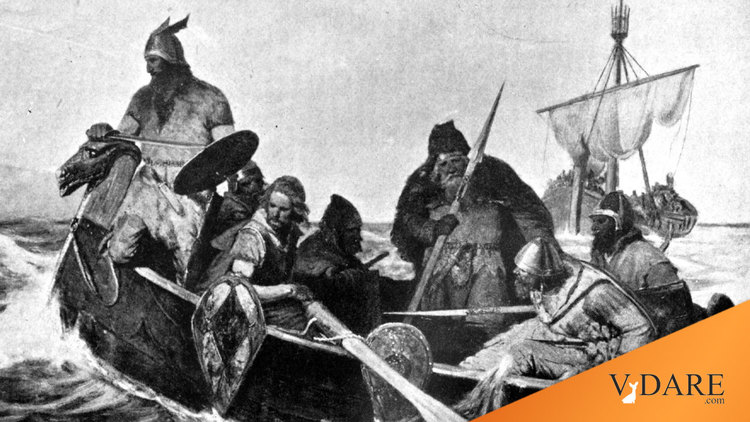
ATLANTA JOURNAL-CONSTITUTION: Vikings Weren’t European
By Steve Sailer
10/21/2021
Vikings landed in America 1,000 years ago, long before Europeans https://t.co/Z495gs4IoB
— Atlanta Journal-Constitution (@ajc) October 21, 2021
The actual new scientific study the AJC is reporting on is fun:
But in results published Wednesday in Nature, scientists presented what they think are new answers to this mystery. By analyzing the imprint of a rare solar storm in tree rings from wood found at the Canadian site, scientists have decisively pinned down when Norse explorers were in Newfoundland: the year A.D. 1021, or exactly 1,000 years ago.
To be precise, they pinned down that Vikings cut some trees down in Newfoundland with a metal axe exactly 1,000 years ago this year. They may well have also been in the New World earlier or later. But, we now know for sure they were there in 1021.
“It was the first time the Atlantic Ocean was crossed,” he said, adding that establishing exact dates helps mark a turning point in the history of human movement around the planet.
Once again, we now have precise data for the oldest known crossing of the Atlantic (and back) for which we have both literary and archaeological evidence. I’d hardly be surprised if people had previously made one-way crossings of the Atlantic (e.g., Greenland Eskimos in kayaks have washed up in Norway in more recent centuries) but never gotten home.
To determine when the site was occupied with greater precision, Dee and his colleagues analyzed three pieces of wood from L’Anse aux Meadows. Each piece, originating from a different tree and still bearing its outer bark, had been cleanly cut with a metal tool, perhaps an ax. That’s a giveaway this wood was cleaved by Vikings, said Margot Kuitems, an archaeologist at the University of Groningen, and a member of the team.
“The local people didn’t use metal tools,” she said.
Interestingly, a lot of copper was mined around and in Lake Superior, but North American Indians didn’t develop smelting. Andean Indians were smelting bronze and Mexican Indians appeared to be on the verge of a Bronze Age in 1492, but American and Canadian Indians lagged. (Interestingly, Pacific Northwest Indians made use of Japanese iron that washed up in shipwrecks.)
… Only a fleeting fraction is radioactive carbon 14, also called radiocarbon. That isotope of carbon is produced when cosmic rays — high-energy particles from the sun or beyond the solar system — interact with atoms in Earth’s atmosphere.
Scientists who study cosmic rays used to think that these particles arrived in a relatively constant barrage, meaning that the ratio of carbon 14 to carbon 12 in the atmosphere has largely remained steady over time. But then in 2012, researchers found two cedar trees in Japan that recorded inexplicably high levels of radiocarbon in their rings dating A.D. 774 to 775. That spike is now known as a Miyake event for its discoverer, Fusa Miyake, a cosmic ray physicist at Nagoya University in Japan. Other Miyake events have since been spotted in tree ring records, but they remain exceedingly rare.
But it just so happened that another Miyake event occurred during the Viking Age, in A.D. 992 to 993. Trees found worldwide record an uptick in carbon 14 around that time, and wood found at L’Anse aux Meadows should be no exception. In the hopes of pinning down the age of the Americas’ only confirmed Viking settlement, Dee and his colleagues turned to the unlikely marriage of dendrochronology — the study of tree rings — and astrophysics.
Good work.
